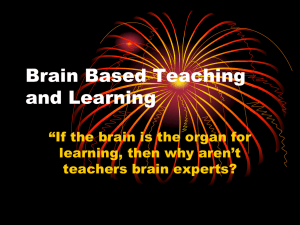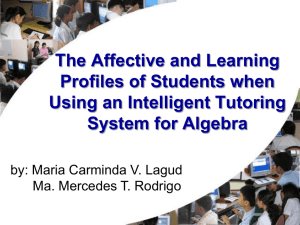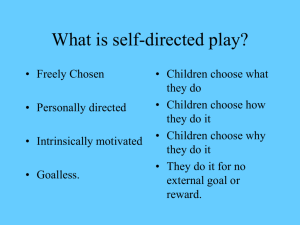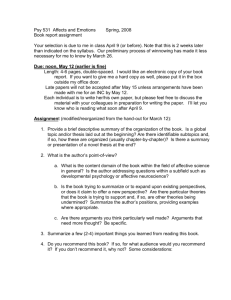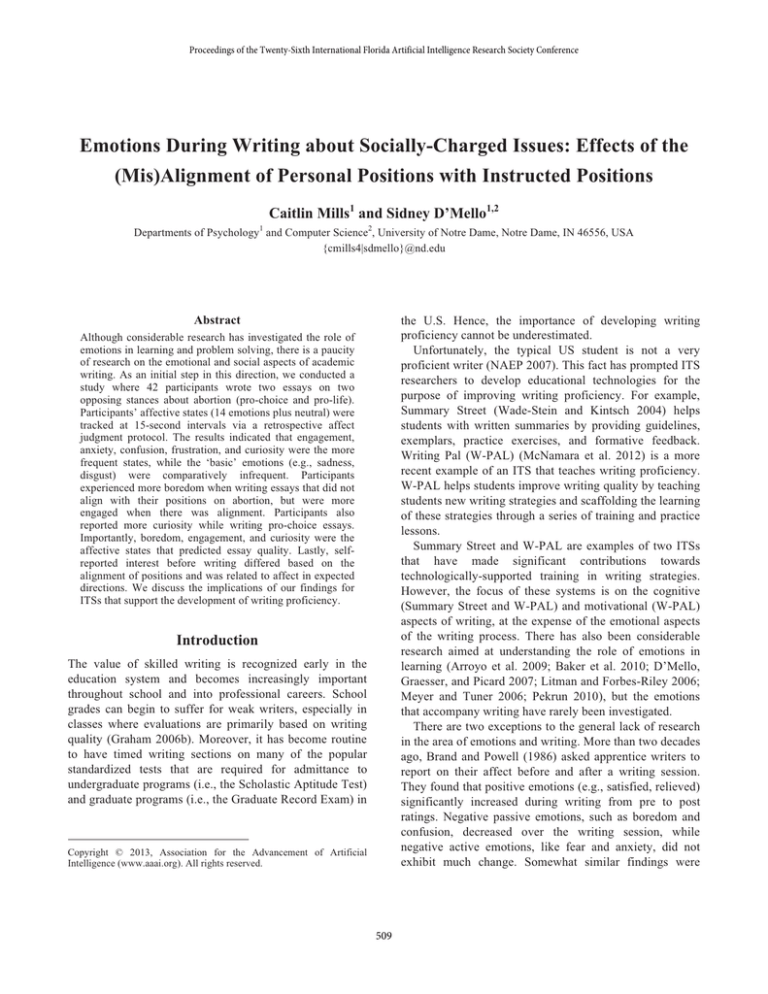
Proceedings of the Twenty-Sixth International Florida Artificial Intelligence Research Society Conference
Emotions During Writing about Socially-Charged Issues: Effects of the
(Mis)Alignment of Personal Positions with Instructed Positions
Caitlin Mills1 and Sidney D’Mello1,2
Departments of Psychology1 and Computer Science2, University of Notre Dame, Notre Dame, IN 46556, USA
{cmills4|sdmello}@nd.edu
the U.S. Hence, the importance of developing writing
proficiency cannot be underestimated.
Unfortunately, the typical US student is not a very
proficient writer (NAEP 2007). This fact has prompted ITS
researchers to develop educational technologies for the
purpose of improving writing proficiency. For example,
Summary Street (Wade-Stein and Kintsch 2004) helps
students with written summaries by providing guidelines,
exemplars, practice exercises, and formative feedback.
Writing Pal (W-PAL) (McNamara et al. 2012) is a more
recent example of an ITS that teaches writing proficiency.
W-PAL helps students improve writing quality by teaching
students new writing strategies and scaffolding the learning
of these strategies through a series of training and practice
lessons.
Summary Street and W-PAL are examples of two ITSs
that have made significant contributions towards
technologically-supported training in writing strategies.
However, the focus of these systems is on the cognitive
(Summary Street and W-PAL) and motivational (W-PAL)
aspects of writing, at the expense of the emotional aspects
of the writing process. There has also been considerable
research aimed at understanding the role of emotions in
learning (Arroyo et al. 2009; Baker et al. 2010; D’Mello,
Graesser, and Picard 2007; Litman and Forbes-Riley 2006;
Meyer and Tuner 2006; Pekrun 2010), but the emotions
that accompany writing have rarely been investigated.
There are two exceptions to the general lack of research
in the area of emotions and writing. More than two decades
ago, Brand and Powell (1986) asked apprentice writers to
report on their affect before and after a writing session.
They found that positive emotions (e.g., satisfied, relieved)
significantly increased during writing from pre to post
ratings. Negative passive emotions, such as boredom and
confusion, decreased over the writing session, while
negative active emotions, like fear and anxiety, did not
exhibit much change. Somewhat similar findings were
Abstract
Although considerable research has investigated the role of
emotions in learning and problem solving, there is a paucity
of research on the emotional and social aspects of academic
writing. As an initial step in this direction, we conducted a
study where 42 participants wrote two essays on two
opposing stances about abortion (pro-choice and pro-life).
Participants’ affective states (14 emotions plus neutral) were
tracked at 15-second intervals via a retrospective affect
judgment protocol. The results indicated that engagement,
anxiety, confusion, frustration, and curiosity were the more
frequent states, while the ‘basic’ emotions (e.g., sadness,
disgust) were comparatively infrequent. Participants
experienced more boredom when writing essays that did not
align with their positions on abortion, but were more
engaged when there was alignment. Participants also
reported more curiosity while writing pro-choice essays.
Importantly, boredom, engagement, and curiosity were the
affective states that predicted essay quality. Lastly, selfreported interest before writing differed based on the
alignment of positions and was related to affect in expected
directions. We discuss the implications of our findings for
ITSs that support the development of writing proficiency.
Introduction
The value of skilled writing is recognized early in the
education system and becomes increasingly important
throughout school and into professional careers. School
grades can begin to suffer for weak writers, especially in
classes where evaluations are primarily based on writing
quality (Graham 2006b). Moreover, it has become routine
to have timed writing sections on many of the popular
standardized tests that are required for admittance to
undergraduate programs (i.e., the Scholastic Aptitude Test)
and graduate programs (i.e., the Graduate Record Exam) in
Copyright © 2013, Association for the Advancement of Artificial
Intelligence (www.aaai.org). All rights reserved.
509
position with instructed position might trigger appraisals of
increased value, which would increase motivation to write,
and positively impact engagement. On the other hand,
misalignment of personal position and instructed position
might lead to lower appraisals of value, less motivation,
and increased boredom.
This question was tested in a study where 42 participants
were asked to write essays while adopting a pro-choice and
a pro-life stance on abortion1. We selected the topic of
abortion because it is controversial, individuals have strong
beliefs, and individuals in the U.S. are approximately
evenly divided in the stance they adopt. We focused on
answering four research questions: (1) What affective
states do writers experience when writing about abortion?
(2) How are affective states influenced by personal
position, instructed position, and the interaction between
(mis)alignment of these two factors, (3) Are affective
states predictive of writing quality? and (4) How do
perceptions of writing relate to the alignment of positions
and affective states during writing?
reported when Brand and Leckie (1988) asked professional
writers to report on their affect three different times (i.e.,
before, a pause during, and after the writing session).
More recently, D’Mello and Mills (in review)
investigated the emotions that students experienced during
short writing sessions on three different topics (e.g.,
academic, socially-charged, and personal emotional
experiences). Academic topics were adapted from the ACT
(e.g., “the use of class discussion”) and socially charged
topics focused on issues like “abortion” or “the death
penalty.” Personal emotional experience topics involved
writing about recent experience with emotions such as
anger, happiness, and fear. The findings supported the
hypothesis that writing is an emotionally charged activity,
as the fourteen affective states accounted for 78.9% of the
observations compared to neutral (21.1%). The most
frequent affective states were engagement/flow, boredom,
anxiety, confusion, frustration, and happiness.
With the exception of these two examples, neither the
writing research community nor the ITS community has
sufficiently investigated the emotion-cognition link in the
context of academic writing other than work on the
positive effects of expressive writing on well-being
(Pennebaker 1997). The present paper addresses this issue
by analyzing the emotions that naturally arise during
writing about socially-charged issues. We focused on
socially-charged issues because previous research
indicated that writers were less likely to experience
boredom when composing essays on these topics compared
to the more traditional academic writing prompts (D’Mello
and Mills in review). However, there might be a liability in
assigning these social topics because they are usually
controversial and people may have strong opinions on
opposing sides of these issues. To further investigate this
issue, the present focus was on uncovering how emotions
are influenced by writers' positions on socially-charged
issues. More specifically, how does the alignment or
misalignment between personal beliefs and instructed
essay position impact writers' emotions? For example, will
an alcoholic, a social drinker, and a teetotaler (behavior
regarding alcohol consumption) have the same emotional
experiences when asked to write about reinstating the 1920
ban on alcohol (instructed position)?
Although there is little data to address this question, the
control-value theory of academic emotions (Pekrun et al.
2007) provides some testable hypotheses on how emotions
are affected by the (mis)alignment of actual positions and
instructed positions. This theory posits that appraisals of
control and value of a learning activity are important
antecedents of the emotions that arise during learning.
Subjective control pertains to the perceived influence that a
person has over the activity, while subjective value
represents the perceived value of the outcomes of the
activity. According to this theory, alignment of personal
Methods
Participants and Design
The participants were 42 undergraduates from an urban
U.S. university who participated for course credit. The
study had a within-subjects design in which the
participants were required to write in support of both prochoice and pro-life perspectives on abortion. The ordering
of the essay topic was counterbalanced across participants.
None of the participants refused to write about either
position on abortion. Participants were asked to rate their
own stance on abortion after writing both essays and
40.5% of participants self-identified as being pro-life while
59.5% self-identified as being pro-choice.
Procedure
Participants were instructed to present a coherent argument
for the pro-choice/pro-life position, regardless of what their
actual position on abortion may be. Participants were
given 15 minutes to complete the first essay. They were
then given an additional 15 minutes to write a second essay
that adopted a position opposite to the first essay (e.g., prochoice first and pro-life second or pro-life first and prochoice second). Participants typed their essays on a
computer interface and the content of the essays was stored
in text files for offline analysis. Videos of participants’
faces and computer screens were also recorded.
1
A short (500 word) version of this paper that featured some preliminary
analyses was presented as a poster at another conference (see Mills &
D’Mello, 2012). This full paper is a significant expansion of the poster in
terms of theoretical, explanatory, and analytical depth.
510
Participants provided self-judgments of their affective
states immediately after the writing session via a
retrospective affect judgment procedure (D’Mello and
Graesser 2011; Graesser at al. 2006; Rosenberg and Ekman
1994). Participants viewed a video of their face along with
the screen capture video of their writing session on a
widescreen monitor. The screen capture included the
writing prompt and dynamically presented the text as it
was written, thereby providing the context of the writing
session.
Participants were instructed to make judgments on what
affective states were present at any moment during the
writing session by manually pausing the videos
(spontaneous judgments). They were also instructed to
make judgments at each 15-second interval where the
videos automatically stopped (fixed judgments).
Participants made their ratings via a computer interface
that allowed them to select one out of 14 affective states
(anger, anxiety, boredom, confusion, contempt, curiosity,
delight, disgust, happiness, engaged, fear, frustration,
sadness, surprise) plus neutral. This method allows for the
emotion judgments to be made on the basis of a
combination of participants’ facial expressions, contextual
cues via the screen capture, the definitions of the states
(presented on a sheet), and their memories of the recently
completed writing session.
Participants also completed a questionnaire before and
after writing each essay to measure their prospective and
retrospective attitudes of writing on the given topic. All
questions were answered on a scale of 1 to 6. The four prewriting questions assessed participants’ confidence, level
of comfort, and interest in writing about the given topic, as
well as how much effort they would put into writing about
that topic (e.g., How much effort would you put into
writing an essay that opposes abortion?). The five postwriting questions assessed participants’ perception of the
essay quality, if they would have liked more time to write,
as well as their levels of emotional involvement, general
engagement, and effort during writing.
Results and Discussion
Proportion of Affective States During Writing
The retrospective affect judgment protocol yielded a total
of 5,462 emotion observations across the 42 participants.
Table 1 presents descriptive statistics on the proportional
occurrence of affective states averaged across both essays.
75.0% of the observations involved at least one affective
state while the remaining 25.0% of observations were
neutral. This finding is consistent with previous research
indicating that affective states are quite prominent during
writing activities (Brand and Powell 1986; Brand and
Leckie 1988, D’Mello and Mills in review).
Only six out of the fourteen affective states (excluding
neutral) occurred with some regularity. Engagement/flow
was the most frequently reported, accounting for 31.7% of
the observations. Boredom and confusion occurred at
similar rates and were the two next most frequent states.
Three other affective states (anxious, curiosity, and
frustration) occurred at least three percent of the time.
Similar to a previous study that included considerably
more topic choices, it was the learning-centered states, not
the basic emotions, that were more prominent (D’Mello
and Mills in review). The seven basic emotions accounted
for only 9.4% of the observations, while the learningcentered states comprised 65.6% of the affect reports.
Table 1. Mean proportional occurrence of affective states across
learners
Scoring Essays
The essays were scored based on a modified version of a
standardized rubric used to grade essays from the SAT
(McNamara, Crossley, and McCarthy 2010). Essay quality
was scored on a 6-point scale with a score of 1 indicating
little or no mastery with several major flaws, 3 indicating
developing mastery with one or more major flaws, and 6
indicating clear and consistent mastery with minor errors.
The essays were randomized and scored by a trained judge.
The judge was blind to participant identity and actual
positions on abortion. Reliability (r = .906) was obtained in
a previous study with similar essays.
Basic Emotions
M
Learning-Centered
M
Anger
Contempt
Disgust
Fear
Happiness
Sadness
Surprise
.012
.027
.011
.002
.022
.016
.004
Anxious
Boredom
Confusion
Curiosity
Delight
Engaged/Flow
Frustration
.031
.099
.097
.034
.018
.317
.060
Neutral
.250
Effect of Instructed Position and Actual Position
The question of whether instructed essay positions and
actual positions on abortion influenced the affective states
was investigated by constructing separate mixed effects
binary logistic regression models for the six most frequent
states
(anxious,
boredom,
confusion,
curiosity,
engagement/flow, and frustration). Mixed effects logistic
regression modeling is the recommended analysis for the
present data because (a) the dependent variable was binary,
(b) there were multiple observations for each participant,
511
wrote pro-choice essays compared to pro-life essays.
Conversely, there was significantly less engagement (B = .322) when the pro-life participants wrote pro-choice
essays compared to pro-life essays.
Taken together, these results suggest that the
(mis)alignment of instructed and actual position impact
boredom and engagement levels during writing. Boredom
is more likely to occur when there is misalignment but
engagement is higher when there is alignment (see Figure
1). These results are intuitively plausible and are consistent
predictions from the control-value theory of emotions
(Pekrun et al. 2007).
Mean Proportional Occurrence
and (c) the effects of extraneous random factors such as
participant and essay order need to be accounted for
(Pinheiro and Bates 2000).
The data was analyzed at the item level with the
dependent variable being an indicator variable denoting the
presence (1) or absence (0) of each affective state. The
random effects were participant (categorical with 42
levels) and order of instructed position (i.e., pro-choice
first vs. pro-life first). The fixed effects were instructed
position, actual position, and the instructed × actual
interaction.
Significant models (p < .05 unless specified otherwise)
were
discovered
for
curiosity,
boredom,
and
engagement/flow, but not for anxious, confusion, and
frustration. For curiosity, the main effect of instructed
position was significant. It appears that participants were
significantly more likely to experience curiosity when
asked to write a pro-choice essay compared to a pro-life
essay, irrespective of their actual positions on abortion.
The main effect of actual position and the instructed ×
position interaction were not significant for curiosity.
The instructed position × actual position interaction was
significant for boredom. This interaction was probed by
dividing the data on the basis of actual position and
regressing boredom on instructed position. The results
indicated that the pro-choice participants were less likely
(B = -.735) to report boredom when writing pro-choice
essays compared to pro-life essays. However, the pro-life
participants were more likely to report boredom (B = .547)
when writing pro-choice essays compared to pro-life
essays (See Figure 1).
Predicting Essay Quality
Since we found a difference in affective states based on
alignment, we investigated if there was a difference in
quality of essays based on alignment. A paired samples ttest comparing the quality score of essays between the
aligned (M = 3.48, SD = 1.38) and misaligned essays (M =
3.36, SD = 1.41) revealed there was no significant
difference, t(41) = -.525, p > .05.
The results have indicated that boredom, engagement,
and curiosity were the affective states that were influenced
by the (mis)alignment between the instructed position and
actual position on abortion. But were these states
associated with writing outcomes? This question was
addressed by constructing a mixed effects linear regression
model with essay score as the dependent variable.
Participant and order of instructed position were the
random effects. Boredom, engagement, and curiosity were
included as the categorical fixed effects and were all
significant predictors of essay quality. Boredom negatively
predicted essay scores (B = -.118), whereas engagement/
flow (B = .111) and curiosity (B = .152) positively
predicted essay quality. These coefficients are in expected
directions with respect to what is known about the harmful
effects of boredom and the benefit of engagement and
curiosity (Craig et al. 2004; Pekrun et al. 2010).
0.4
0.3
Engaged
0.2
Alignment and Pre-Perceptions of Writing
0.1
Bored
We also investigated if perceptions before writing differed
based on the alignment or misalignment of positions (See
Table 2 for descriptive statistics). There were no alignment
differences for potential effort, comfort, or confidence in
writing about abortion. However, participants reported
more interest when writing aligned essays (M = 4.40, SD =
1.43) compared to misaligned essays (M = 3.43, SD =
1.61), t(41)= -2.92, p = .006.
The finding that participants’ interest in writing covaried
as a function of (mis)alignment between their actual
positions and instructed positions raised the question of
whether interest is related to affect? We proceeded by
proportionalizing the distribution of affect reports, so that
0
Alignment of
Opinions
Misalignment of
Opinions
Fig. 1. Alignment vs. Misalignment of Instructed
Essay Position and Actual Opinions Trends
The instructed position × actual position interaction for
engagement was also significant and showed an opposite
pattern to boredom. There was significantly more
engagement (B = .474) when the pro-choice participants
512
being the most frequent states. Hence, there might be some
merits to strategically responding to these states as they
arise, a possibility that is discussed in more detail below.
Second, we have shown that a simple matter of
(mis)alignment between a writer’s actual position on a
topic and instructed position can impact what writers bring
to the task (more interest before writing), what affective
states they experience during the task (more
engagement/flow, curiosity, and less boredom), and their
retrospective evaluations of the writing task (more effort
and emotional involvement). Although there were no
alignment effects on writing outcomes, increased levels of
engagement/flow and curiosity and lower levels of
boredom observed when there was alignment were
predictive of writing outcomes. This suggests that affect
moderates the effect of (mis)alignment on writing
outcomes, a hypothesis that awaits more systematic testing.
These findings have a number of implications for ITSs
aiming to help students improve their writing skills. ITSs
that can detect affect during writing might respond
automatically when disadvantageous emotions arise. For
example, since boredom was prevalent during writing and
was a negative predictor of writing scores, ITSs might
intervene to reengage the writer once boredom is detected.
One intervention might include dynamically probing the
writer about ideas for the composition (e.g., have you
thought of your supporting sentences?). An ITS with
boredom-alleviation capabilities has considerable potential
to help writers develop proficiency by keeping students
engaged in the deliberate practice of writing strategies.
We have begun to make some advances along this front
in order to automatically detect if a writer is bored or
engaged. We have developed a system that automatically
discriminates between these two states in 15 second
intervals by analyzing the dynamics of content production
(i.e., keystroke patterns and pauses), prospective appraisals
of the writing topic (pre-writing survey questions),
individual differences in scholastic aptitude, exposure to
print, and writing apprehension (not discussed here)
(Bixler & D’Mello, in press). We achieved accuracy rates
of 87%, which reflects a 37.4% improvement over random
guessing, in discriminating boredom from engagement.
The next step of this research is to implement and evaluate
interventions that respond to the sensed boredom, which
awaits further research and technological development.
Our results also suggests there might be some liability in
assigning topics where there is misalignment between the
writer’s position and the instructed position. Therefore, one
idea to facilitate engagement is for ITSs to provide choices
that align with writers’ opinions. Indeed, freedom of choice
is an important predictor of curiosity and engagement
(Lepper and Woolverton 2002). However, it is also
important to realize that students are typically not afforded
choice over topics for most educational writing activities
for every participant and essay the sum of proportions for
the affective states equaled 1.0. Since the distributions of
affective states significantly violated assumptions of
normality, non-parametric tests were used for these
analyses. A correlation between affective states and
interest revealed that interest was negatively related to
boredom (rho = -.333, p = .031), as well as slightly
positively correlated with curiosity (rho = .170 p = .281)
but not with flow/engagement (rho = -.115 p = .467). This
suggests that perceived interest before writing ever begins
is reliably related to lower levels of boredom.
Table 2. Descriptive Statistics for Paired Samples t-tests
Alignment
M (SD)
Pre-Writing Questions
Potential Effort
5.33 (.650)
Confident about
Writing
4.43 (1.33)
Comfortable with
4.86 (1.37)
Writing
Interest in Writing
4.40 (1.48)
Post-Writing Questions
Effort Exerted
5.38 (.539)
Emotionally Involved 4.81 (1.02)
Engagement
5.19 (.804)
Quality Rating
4.19 (1.25)
More Time Needed
3.33 (1.78)
Misalignment
M (SD)
d
5.17 (.762)
.212
4.12 (1.38)
.166
4.26 (1.67)
3.43 (1.61)
.261
*.448
4.98 (.749)
4.33 (1.14)
4.93 (.947)
3.98 (1.16)
3.67 (1.88)
*.567
*.397
.252
.189
-.158
Notes. * Paired sample t-test significant, p < .05
Alignment and Post-Perceptions of Writing
Post-writing perceptions were also analyzed by conducting
paired-samples t-tests to compare differences between
aligned essays and misaligned essays (See Table 2).
Participants reported being significantly (p < .05) more
emotionally involved, exerting more effort, and generally
being more engaged (p = .109) when there was alignment
between actual position and instructed position. These
perceptions align with the retrospective affect judgment
ratings of engagement. Specifically, participants perceived
themselves as more engaged when their positions aligned
with the instructed position by reporting more effort,
emotional involvement, and general engagement.
General Discussion
This paper offers a fine-grained investigation of affect
during writing, a topic that is much neglected in the
educational, ITS, and writing communities. The present
study makes two key contributions to the literature. First,
our data indicates that affective states spontaneously occur
throughout the writing process with engagement/flow,
boredom, confusion, frustration, curiosity, and anxiety
513
Graham, S. 2006b. Writing. In P. Alexander & P. Winne (Eds.)
Handbook of educational psychology. Mahwah, NJ: Erlbaum
Lepper, M., & Woolverton, M. 2002. The wisdom of practice:
Lessons learned from the study of highly effective tutors. In J.
Aranson (Ed.) Improving Academic Achievement: Impact of
Psychological Factors on Education, pp. 135--158. New York:
Academic Press.
Litman, D., & Forbes-Riley, K. 2006. Recognizing student
emotions and attitudes on the basis of utterances in spoken
tutoring dialogues with both human and computer tutors. Speech
Communication 48(5): 559-590.
McNamara, D. S., Crossley, S. A., & McCarthy, P. M. 2010.
Linguistic features of writing quality. Written Communication.
27(1):57-86.
McNamara, D.S., Raine, R., Roscoe, R., Crossley, S., Jackson,
G.T., Dai, J., Cai, Z., Renner, A., Brandon, R., Weston, J.,
Dempsey, K., Lam, D., Sullivan, S., Kim, L., Rus, V., Floyd, R.,
McCarthy, P.M., & Graesser, A.C. 2012. The Writing-Pal:
Natural language algorithms to support intelligent tutoring on
writing strategies. In P.M. McCarthy and C. Boonthum, (Eds.)
Applied natural language processing and content analysis:
Identification, investigation, and resolution, pp. 298-311.
Hershey, PA: IGI Global.
Meyer, D., & Turner, J. 2006. Re-conceptualizing emotion and
motivation to learn in classroom contexts. Educational
Psychology Review 18(4):377-390.
Mills, C., & D’Mello, S. K. 2012. Emotions during writing on
topics that align or misalign with personal beliefs. Poster
presented at the 11th International Conference on Intelligent
Tutoring Systems, Crete, Greece.
Pekrun, R. 2010. Academic emotions. In T. Urdan (Ed.), APA
Educational Psychology Handbook, vol. 2, pp. 3-31. Washington:
American Psychological Association.
Pekrun, R., Goetz, T., Daniels, L., Stupnisky, R. H., & Raymond,
P. 2010. Boredom in achievement settings: Exploring control–
value antecedents and performance outcomes of a neglected
emotion. Journal of Educational Psychology. 102(3), 531-549.
Pekrun, R., Frenzel, A., Goetz, T., & Perry, R. P. 2007. The
Control–Value Theory of Achievement Emotions: An Integrative
Approach to Emotions in Education. In: P. A. Schutz & R.
Pekrun (Eds.) Emotion in Education. pp. 13--36. San Diego:
Academic Press.
Pennebaker, J.W. 1997. Writing about emotional experiences as a
therapeutic process. Psychological Science 8(3):162-166.
Pinheiro, J. C., & Bates, D. M. 2000. Mixed-effects Models in S
and S-PLUS. New York: Springer Verlag.
Rosenberg, E., & Ekman, P. 1994. Coherence between expressive
and experiential systems in emotion. Cognition & Emotion
8(3):201-229.
Strain, A.C., & D’Mello, S.K. 2011. Emotion Regulation During
Learning. In: G. Biswas, S. Bull, J. Kay, & A. Mitrovic (eds.)
Proceedings of 15th International Conference on Artificial
Intelligence in Education, 566-568, Berlin: Springer-Verlag.
U.S. Department of Education, Institute of Education Sciences,
National Center for Education Statistics, National Assessment of
Educational Progress (NAEP), 2007 Writing Assessment.
Wade-Stein D, Kintsch E. 2004. Summary Street: Interactive
computer support for writing. Cognition and Instruction
22(3):333-362.
(e.g., class papers, standardized tests). Hence, ITSs might
implement cognitive reappraisal techniques before the
writing session begins, particularly when students find the
topics uninteresting or topics misalign with their beliefs
(Strain & D’Mello 2011). For example, an ITS might ask
the writer to imagine a situation where he or she must write
a high quality essay, despite his or her beliefs on topic X,
to gain admission into a top college. This reappraisal
technique might help students overcome the negative
experience of boredom by providing a motivation for
writing, even about topics that do not align with their
views.
Acknowledgments
This research was supported by the National Science
Foundation (NSF) (ITR 0325428, HCC 0834847, DRL
1235958). Any opinions, findings and conclusions, or
recommendations expressed in this paper are those of the
authors and do not necessarily reflect the views of NSF.
References
Arroyo, I., Woolf, B., Cooper, D., Burleson, W., Muldner, K., &
Christopherson, R. 2009. Emotion Sensors Go to School. In
Dimitrova, V., Mizoguchi, R., du Boulay, B., & Graesser, A.
(Eds.) Proceedings of 14th International Conference on Artificial
Intelligence in Education. Amsterdam: IOS Press.
Baker, R.S.J.d, D’Mello, S.K., Rodrigo, M.T., Graesser, A.C.
2010. Better to be frustrated than bored: The incidence and
persistence of affect during interactions with three different
computer-based learning environments. International Journal of
Human-Computer Studies 68(4): 223-241.
Bixler, R., & D'Mello, S. K. (in press). Detecting Boredom and
Engagement During Writing with Keystroke Analysis, Task
Appraisals, and Stable Traits. Proceedings of the 2013 Annual
Conference on Intelligent User Interfaces (IUI 2013)
Brand, A. G., & Leckie, P. A. 1988. The emotions of professional
writers. Journal of Psychology. 122(5):421-439.
Brand, A. G., & Powell, J. L. 1986. Emotions and the writing
process: A description of apprentice writers. Journal of
Educational Research 79(5):280-285.
Craig, S., Graesser, A., Sullins, J., & Gholson, B. 2004. Affect
and learning: An exploratory look into the role of affect in
learning. Journal of Educational Media 29(3), 241-250.
D’Mello, S.K., & Graesser, A.C. 2011. The half-life of cognitiveaffective states during complex learning. Cognition & Emotion
27(5):1299-1308.
D’Mello, S.K., Graesser, A.C., & Picard, R.W. 2007. Towards an
Affect-Sensitive AutoTutor. IEEE Intelligent Systems 22(4):5361.
D’Mello, S.K., & Mills, C. Emotions during writing. (in review)
Graesser, A.C., McDaniel, B., Chipman, P., Witherspoon. A.,
D’Mello, S.K., Gholson, B. 2006. Detection of Emotions during
Learning with AutoTutor. In Proceedings of the 28th Annual
Meetings of the Cognitive Science Society, 285 – 290. Vancouver,
Canada.
514


